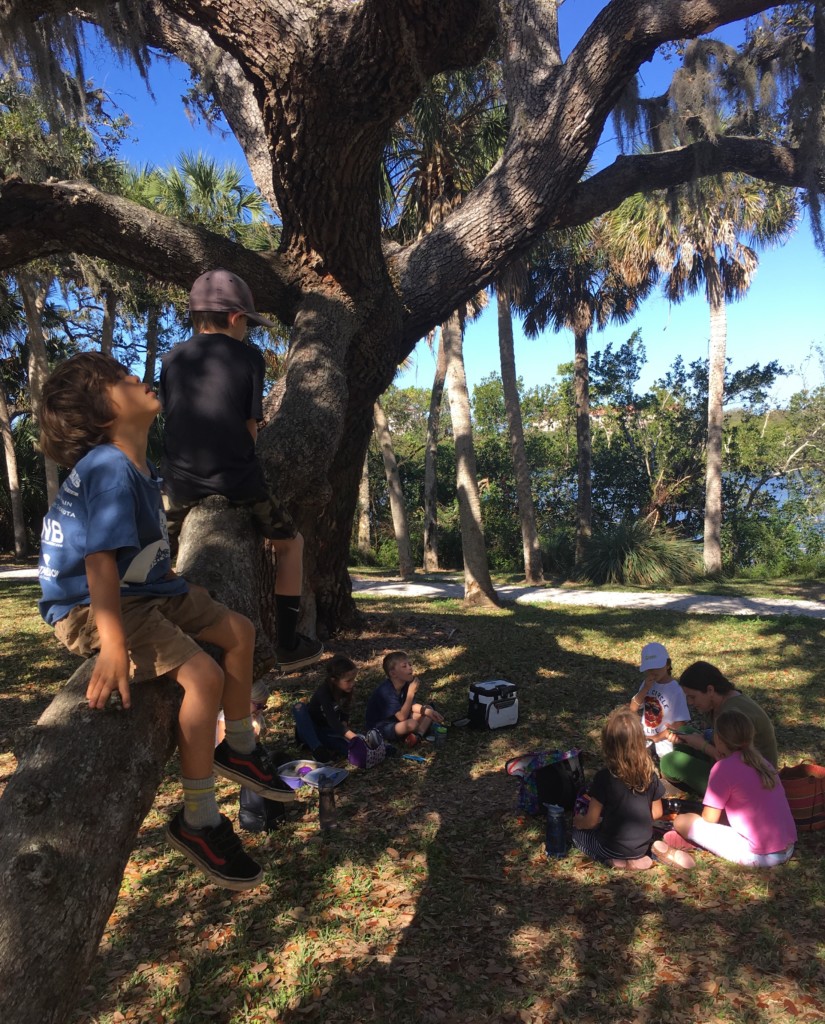
This is the latest in our series on the center-left roots of school choice.
SARASOTA, Fla. — At a nature park bedecked by oaks and palms, a teacher at Mangrove School mimics a wolf call through cupped hands, signaling to scattered students that it’s time to breeze over. “Let’s greet the day,” the teacher says. They all join hands, then take turns facing east, south, west, and north as their teacher offers thanks. To the rising sun. The palms and coonti. The manatees and crabs. Even to the soil.
So class begins at another choice school that defies stereotypes – and conjures possibilities.
On the one hand, Mangrove School is just another one of 2,000 private schools that accept Florida school choice scholarships. On the other, its mission to “honor childhood,” “promote world peace” and “instill reverence for humanity, animal life, and the Earth” is impossible to square with a pernicious myth – on the policy landscape, the equivalent of an invasive species – that school choice is being rammed into place by forces that progressives find nefarious.
“I hear that, and I look around here, and I think it’s very strange,” said Mangrove School director Erin Melia, a former chemist with a master’s degree in education. “I would think it (the perception) would be the opposite. The people most in need of choice are the people left behind.”
Mangrove School started as a play group 18 years ago. Now it has 43 students from Kindergarten to sixth grade, including eight home-schoolers who attend part-time. Nineteen of 35 full-timers use some type of school choice scholarship, most of them the Florida Tax Credit Scholarship for lower-income students.*
“We’re just trying to be available to as many families as possible,” Melia said.
That’s a standard view among private schools participating in Florida choice programs, including plenty of “alternative” schools. (Like this one, this one, this one and this one). Those private schools serve more than 100,000 tax credit scholarship students alone. Their average family incomes barely edge the poverty line, and three in four are children of color. Yet the narrative about conservative cabals feels as entrenched as ever.
Blame Trump and the media.
Last March, six weeks after he was inaugurated, the most polarizing man on the planet visited an Orlando Catholic school and held up Florida school choice scholarships as a national model. Just like that, they became a bullseye. In subsequent months, The Washington Post, The New York Times, NPR, Scripps, ProPublica, Education Week and Huffington Post all took aim. Every one of them prominently mentioned the connection to Trump and/or Education Secretary Betsy DeVos. Ditto for the Orlando Sentinel, which punctuated the year with a hyperbolic series that attempted to portray the accountability regimen for private schools as broken.
Not a single one of those stories offered a nod to the fuller, richer history behind school choice. Or to its deep roots on the left. Or to the diverse coalition that continues to support it. So, again, a reminder:
Mangrove School isn’t an official Waldorf school, but it’s inspired by the Waldorf model. It emphasizes imagination, creative play and hands-on learning. It chafes at grades, tests and other staples of a standardized education. A few years ago, it dropped tuition from about $10,000 a year to $7,000 a year, to be accessible to more families.
Two of Melia’s children attend Mangrove, and a third uses a Gardiner Scholarship to attend another school. Thanks to school choice, she said, more parents of all political persuasions can find schools in line with their world views, and their kids’ needs.
The same goes for teachers. Mangrove, which also has pre-school students, employs five full-time teachers and 10 part-timers. Melia noted a billboard near the teachers union headquarters in Sarasota that once kept a tally of teachers who’ve left the profession. “They’re just being beaten down,” she said. “Why do you want people who are not inspired to teach?”
As green as it gets
Mangrove may be the “greenest” school in Florida. Students make frequent trips to nature parks and beaches. If there are trees, they climb. If there’s wildlife, they track.
“Having reverence and respect for living things is important,” said teacher Jessica Bromby, who previously taught at Flying Deer Nature Center in New York. “We want to celebrate conscious children.”
Bromby encouraged her 6- and 7-year-olds to give themselves wildlife nicknames. For their first task of the day, Fox Squirrel, Seminole Bat and the others dispersed, picked out a tree – and communed with it. They returned when Bromby cupped her hands again, the time making the sound of a barred owl.
“My tree was really bumpy, and there was a hole in it,” one said when it was her turn to hold the “talking stick” and share her thoughts. “I thought there might be an animal in there.”
“I felt like it was talking to me,” said another. “The water was calling me too.”
‘A better model for our kids’
Jonathan Clark is a second-generation school choice guy. He and his wife turned to homeschooling, then alternative private schools, after their oldest experienced a public elementary school with 1,000 students. They used tax credit scholarships to send him and his siblings to Mangrove.
The district school “was almost like military,” said Clark, an acupuncturist. “Your kid had to walk in straight lines. Couldn’t talk in the hallway. My kid was upset the whole time.”
At Mangrove, he said, children are given freedom to think. Although his family moved to the east coast of Florida and his kids now attend a charter school, they have fond memories of Mangrove and occasionally return to visit. “It was definitely a better model for our kids,” he said.
Mangrove isn’t for everybody. But then, no school is. “Some (students) aren’t going to fit into that box, and it becomes a very unhappy experience for them,” Melia said.
Many parents and teachers still don’t realize how many alternatives there are, she continued. Or how many more there could be.
Maybe as many as everybody wants.
*Step Up For Students, which hosts this blog, administers the Florida tax credit and Gardiner scholarships.



